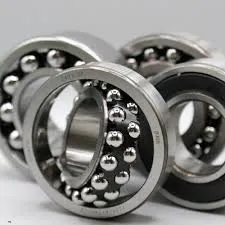
Dec . 05, 2024 16:56 Back to list
Tapered Bearings Sizing Guide and Selection for Optimal Performance
Understanding Tapered Bearings A Focus on Size
Tapered bearings are essential components in various mechanical applications, especially in industries such as automotive, aerospace, and manufacturing. These bearings are designed to accommodate both radial and axial loads, providing increased stability and support for machinery. A critical aspect of tapered bearings is their size, which can significantly affect performance, efficiency, and compatibility with various systems. In this article, we will explore the significance of tapered bearings by size, focusing on the key factors that influence their functionality and selection.
The Basics of Tapered Bearings
Tapered bearings consist of cone-shaped rolling elements that allow for angular contact, enhancing their load-carrying capacity. Unlike traditional ball bearings, which only handle radial loads, tapered bearings efficiently manage both radial and axial forces, making them versatile and reliable. They are commonly used in applications like wheel hubs, gearboxes, and conveyor systems.
Size Specifications
Tapered bearings are categorized based on their dimensions, including the bore diameter, outer diameter, and width (or thickness). These specifications are crucial for ensuring that the bearing fits properly within its housing and can operate effectively under the expected load conditions.
1. Bore Diameter The inner diameter of a tapered bearing is referred to as the bore diameter. It is vital to select a bore size that aligns with the shaft on which the bearing will be mounted. A snug fit is essential for optimal performance, as excessive clearance can lead to increased wear and reduced lifespan.
2. Outer Diameter The outer diameter determines how the bearing fits within its housing. A proper outer diameter ensures that the bearing can bear loads effectively while minimizing the risk of misalignment. Choosing the right outer diameter is crucial for achieving the desired performance characteristics.
3. Width The width of tapered bearings can also impact their load capacity and performance. Wider bearings tend to distribute loads more evenly and withstand higher axial forces. However, increased width can also affect weight and size constraints, making it essential to find a balance that suits specific application needs.
tapered bearings by size

Factors Influencing Bearing Selection by Size
When selecting tapered bearings based on size, several factors should be considered
1. Load Requirements Understanding the types of loads (radial or axial) that will influence the bearing's performance is critical. Engineers must calculate the load capacity needed to choose the appropriate bearing size.
2. Application Type Different applications may require unique bearing sizes based on environmental surrounding conditions (temperature, humidity, etc.) and operational demands (speed, frequency of movement, etc.). For example, high-speed applications may benefit from smaller bearings with lower friction.
3. Material Selection The materials used in tapered bearings can influence size choices. Bearings made from high-strength materials may support heavier loads without significantly increasing size, which is beneficial in applications with space constraints.
4. Operating Conditions Factors such as temperature fluctuations, exposure to contamination, and lubrication also play a role in determining the appropriate size for tapered bearings. Ensuring compatibility with operating conditions can enhance longevity and reliability.
Conclusion
Tapered bearings are indispensable in numerous mechanical systems, primarily due to their unique design that allows them to handle both radial and axial loads efficiently. The size of these bearings, including bore diameter, outer diameter, and width, plays a crucial role in their performance. When selecting tapered bearings, it is vital to consider load requirements, application types, material choices, and operating conditions. A precisely sized tapered bearing can contribute significantly to the overall efficiency and reliability of machinery, ensuring smooth and effective operation. By understanding the importance of size in tapered bearings, engineers and technicians can enhance their decisions, leading to improved performance and longer-lasting equipment.
Latest news
-
Premium Deep Groove Ball Bearings | High Speed & Reliability
NewsAug.29,2025
-
Durable Scaffolding Clamps - Secure & Reliable Tube Connectors
NewsAug.28,2025
-
Common Failures in Thrust Ball Bearings and Solutions
NewsAug.22,2025
-
How Tapered Roller Bearings Can Take Shock Loads
NewsAug.22,2025
-
Angular Bearings in High-Precision Spindles
NewsAug.22,2025
-
The Impact of Misalignment on Cylindrical Roller Bearing Performance
NewsAug.22,2025
